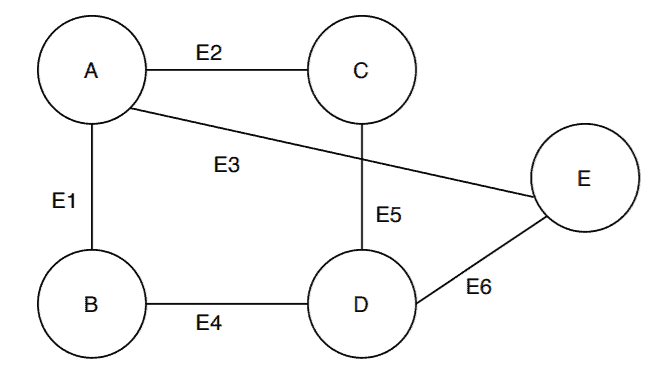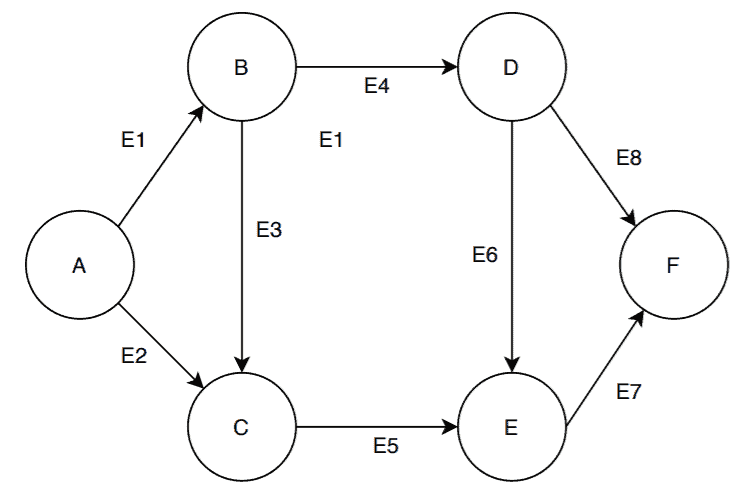1. 概述
在本教程中,我们将讨论 什么是 Incident Edge(关联边),以及它在有向图和无向图中的表现形式。
理解这个概念有助于我们更好地掌握图论中的一些核心操作,比如计算顶点度数、边着色问题、边覆盖问题等。
2. 核心概念
简单来说:
✅ 如果两条边共享一个公共顶点,那么它们就是“关联边”(incident edges)
✅ 顶点也可以与边相关联。如果一个顶点是某条边的端点之一,那么该顶点就与这条边“关联”(incident)
举个例子:假设我们有两条边 e₁ 和 e₂,它们有一个共同的顶点 V,那么 e₁ 和 e₂ 就是关联边。
再比如,如果边 e₃ 连接了顶点 V₁ 和 V₂,那么我们说 e₃ 与 V₁ 和 V₂ 都是关联的。
⚠️ 注意:顶点和边之间的“关联”关系是双向的,既可以说边关联于顶点,也可以说顶点关联于边。
3. 无向图中的例子
我们来看一个无向图的例子:

图 G₁ 包含顶点集合 V = {A, B, C, D, E},边集合 E = {E₁, E₂, E₃, E₄, E₅, E₆}
我们可以观察到以下关联关系:
- 边 E₁、E₂、E₃ 都连接顶点 A → 所以它们是相互关联的
- 顶点 A 与边 E₁、E₂、E₃ 相关联
- 边 E₁ 和 E₄ 共享顶点 B → 所以它们是关联边
- 顶点 B 与边 E₁ 和 E₄ 相关联
以此类推,我们可以找出图中其他边和顶点之间的关联关系。
4. 有向图中的例子
接下来我们看一个有向图的例子:

图 G₂ 的顶点集合为 V = {A, B, C, D, E, F},边集合为 E = {E₁, E₂, E₃, E₄, E₅, E₆, E₇, E₈}
观察图中关联关系:
- 边 E₁ 和 E₂ 都从顶点 A 出发 → 它们是关联边
- 顶点 A 与边 E₁ 和 E₂ 相关联
- 边 E₁ 从 A 指向 B → 所以 E₁ 与 B 是关联的(从 A 出发)
- 边 E₂ 从 A 指向 C → 所以 E₂ 与 C 是关联的(从 A 出发)
✅ 有向图中边具有方向性,因此我们在描述“关联”时,通常会加上方向信息,例如“边 E₁ 从顶点 A 关联到顶点 B”。
⚠️ 踩坑提醒:在有向图中,判断边是否关联时,方向不影响“共享顶点”的判断,但描述时建议说明方向,以避免歧义。
5. 应用场景
关联边的概念在图论中非常基础且实用,常见应用包括:
✅ 计算顶点度数(Vertex Degree)
- 顶点的度数 = 与该顶点关联的边的数量
- 在无向图中直接统计即可
- 在有向图中分为入度(in-degree)和出度(out-degree)
✅ 边着色问题(Edge Coloring)
- 要求:任意两个关联边不能使用相同颜色
- 目标:用最少颜色完成着色
- 参考:Vizing 定理指出颜色数量最多为最大度数 Δ 或 Δ+1
✅ 边覆盖问题(Edge Cover)
- 目标:找出一个边集合,使得图中每个顶点至少与集合中的一条边相关联
- 该集合中的每条边都“覆盖”了一个或多个顶点
6. 总结
在本教程中,我们讲解了:
- 什么是关联边(Incident Edge)
- 无向图和有向图中的关联关系
- 如何判断边与边、边与顶点之间是否关联
- 该概念在图论中的几个关键应用场景
理解“关联”这一概念,有助于更深入地掌握图结构的分析与算法设计。